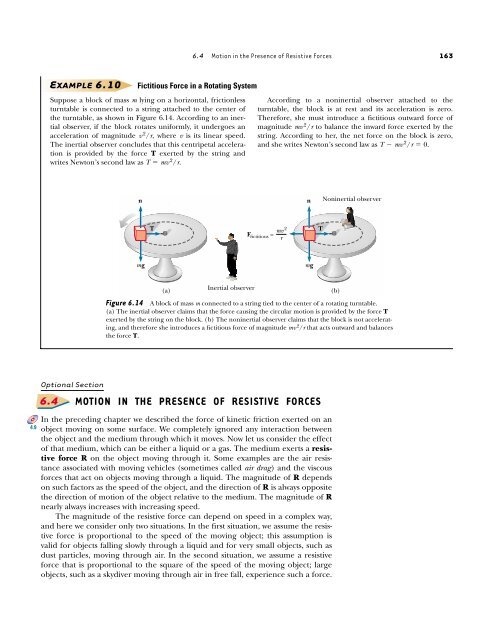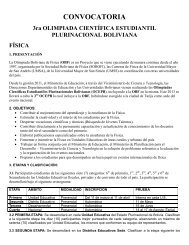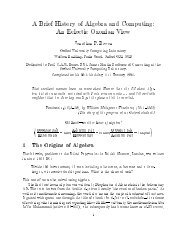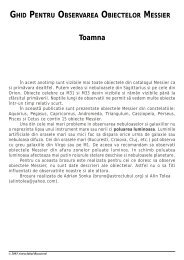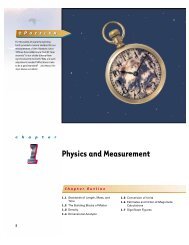Circular Motion and Other Applications of Newton's Laws
Circular Motion and Other Applications of Newton's Laws
Circular Motion and Other Applications of Newton's Laws
You also want an ePaper? Increase the reach of your titles
YUMPU automatically turns print PDFs into web optimized ePapers that Google loves.
4.9<br />
Optional Section<br />
6.4<br />
EXAMPLE 6.10<br />
6.4 <strong>Motion</strong> in the Presence <strong>of</strong> Resistive Forces 163<br />
Fictitious Force in a Rotating System<br />
Suppose a block <strong>of</strong> mass m lying on a horizontal, frictionless<br />
turntable is connected to a string attached to the center <strong>of</strong><br />
the turntable, as shown in Figure 6.14. According to an inertial<br />
observer, if the block rotates uniformly, it undergoes an<br />
acceleration <strong>of</strong> magnitude v 2 /r, where v is its linear speed.<br />
The inertial observer concludes that this centripetal acceleration<br />
is provided by the force T exerted by the string <strong>and</strong><br />
writes Newton’s second law as T � mv 2 /r.<br />
n<br />
m g<br />
T<br />
(a)<br />
Inertial observer<br />
MOTION IN THE PRESENCE OF RESISTIVE FORCES<br />
In the preceding chapter we described the force <strong>of</strong> kinetic friction exerted on an<br />
object moving on some surface. We completely ignored any interaction between<br />
the object <strong>and</strong> the medium through which it moves. Now let us consider the effect<br />
<strong>of</strong> that medium, which can be either a liquid or a gas. The medium exerts a resistive<br />
force R on the object moving through it. Some examples are the air resistance<br />
associated with moving vehicles (sometimes called air drag) <strong>and</strong> the viscous<br />
forces that act on objects moving through a liquid. The magnitude <strong>of</strong> R depends<br />
on such factors as the speed <strong>of</strong> the object, <strong>and</strong> the direction <strong>of</strong> R is always opposite<br />
the direction <strong>of</strong> motion <strong>of</strong> the object relative to the medium. The magnitude <strong>of</strong> R<br />
nearly always increases with increasing speed.<br />
The magnitude <strong>of</strong> the resistive force can depend on speed in a complex way,<br />
<strong>and</strong> here we consider only two situations. In the first situation, we assume the resistive<br />
force is proportional to the speed <strong>of</strong> the moving object; this assumption is<br />
valid for objects falling slowly through a liquid <strong>and</strong> for very small objects, such as<br />
dust particles, moving through air. In the second situation, we assume a resistive<br />
force that is proportional to the square <strong>of</strong> the speed <strong>of</strong> the moving object; large<br />
objects, such as a skydiver moving through air in free fall, experience such a force.<br />
According to a noninertial observer attached to the<br />
turntable, the block is at rest <strong>and</strong> its acceleration is zero.<br />
Therefore, she must introduce a fictitious outward force <strong>of</strong><br />
magnitude mv 2 /r to balance the inward force exerted by the<br />
string. According to her, the net force on the block is zero,<br />
<strong>and</strong> she writes Newton’s second law as T � mv 2 /r � 0.<br />
F fictitious =<br />
Figure 6.14 A block <strong>of</strong> mass m connected to a string tied to the center <strong>of</strong> a rotating turntable.<br />
(a) The inertial observer claims that the force causing the circular motion is provided by the force T<br />
exerted by the string on the block. (b) The noninertial observer claims that the block is not accelerating,<br />
<strong>and</strong> therefore she introduces a fictitious force <strong>of</strong> magnitude mv 2 /r that acts outward <strong>and</strong> balances<br />
the force T.<br />
mv 2<br />
r<br />
n<br />
m g<br />
T<br />
Noninertial observer<br />
(b)


